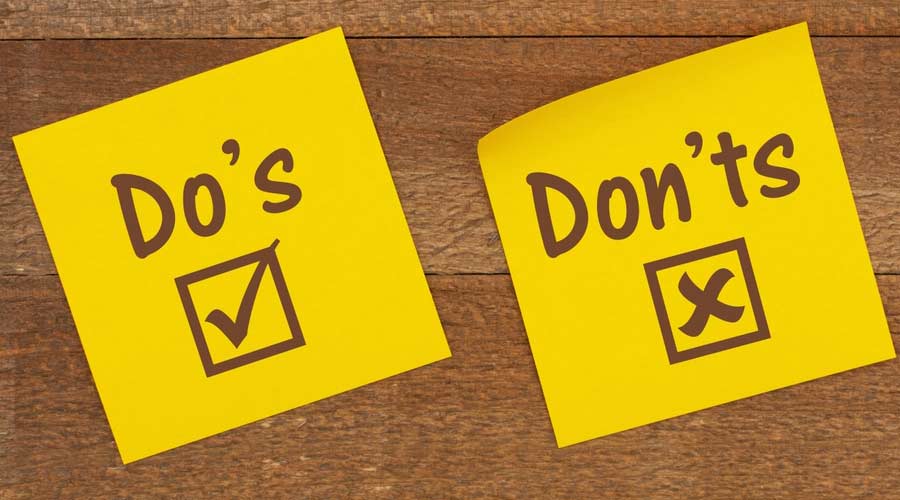In his book Blink, Malcom Gladwell refers to this first impression moment as our “adaptive unconscious.” This part of our brain is similar to a giant computer that quickly and quietly processes a lot of data. Your customer quickly and quietly assesses you—the condition of your van, your uniform, and body language—and then decides if she will let you in.
This is “thin slicing,” which refers to the ability of our unconscious to find patterns in situations and behavior based on very narrow slices of experience. You are being compared to every other service person she has dealt with. If you look shabby, unkempt, and sloppy, your customer will already have an opinion of the type of service you provide.
The Do’s of Working with Residential Carpet Cleaning Customers:
Wear a clean uniform
Work on your grooming
Wear an ID badge
Smile
Look your customer in the eye
While having the technical expertise is critical, even more important is how the technician relates and communicates to the customer. The choice of one or two technicians is up to the company. The consumer, who is most likely female, would prefer two technicians for a couple of reasons:
She feels safer with two people.
She feels her furniture will be properly moved
Two technicians will not complete the job in half the time of one technician, but they will be much faster and more efficient. Two technicians usually are more cost effective. The second technician can be cleaning upholstery or other material in the home while the first technician is cleaning the carpet. This setup also allows for proper training of a second technician.
How to Greet the Customer:
Knock on the door and step back
When the customer answers, smile and hand her your business card
After the customer has invited you in, place a bathmat on the floor and wipe your feet
Look at your clipboard and ask the customer to show you the areas to be cleaned. A good preinspection and communication of your findings will prevent complaints and instill confidence
As the customer gives you a tour, write down any and all comments on your invoice. Ask the customer the following pertinent questions:
How old is the carpet?
Are there any spots or areas of concern?
Are there any pets?
Are there any bad seams, ripples, or loose carpet?
Have there been any previous cleanings? If so, how long ago?
Are there any health concerns of occupants?
Perform a burn test and colorfastness test if needed
Review the areas of concern with the customer and explain what you will do to take care of these areas. Do not over promise. Set realistic expectations for the customer
Start in the furthest area of the home and work your way towards the exit unless the customer requests otherwise
Basic Carpet Cleaning Principles:
Pre-vacuum all edges and entryways. Give extra attention to traffic areas
Move furniture away from walls and clean perimeters first. Remember to tab and block all furniture to prevent staining. Once the perimeter is cleaned, the open areas of the room can be cleaned next. Move furniture back to the exact location where you found it
Precondition and agitate
Perform extraction. Note: Overwetting, which leads to browning, wicking, and longer dry times, is normally caused by technician error. Not enough extraction passes, improper technique, or faulty equipment can cause this
Apply post-treatment chemicals. Protectors are always applied last. Be sure to wipe up any overspray
Groom the carpet. This helps the carpet to dry and improves the overall appearance. Grooming also helps to spread post-treatments and allow for good penetration
Dry the carpet. Use air movers. Turn on ceiling fans with customer’s approval. Check ceiling fans for soil accumulation before activating. Best drying temperature is between 70-72°. Carpet should dry within 6-8 hours
When the job is done…
Review the job with the customer. Make sure everything has been done to her satisfaction. If she has any concerns, even if you think you have done everything possible, try it one more time. Make one final trip through the home to make sure you didn’t leave anything behind
Ask for the check number
Give her tips on maintaining her carpet. Explain the drying process and why it is best for people and pets to stay off the carpet till it is dry. Provide her with traffic lane paper or booties. Emphasize the importance of frequent vacuuming. It is a good idea to inspect her vacuum and point out any concerns, e.g., belts, bags, and brushes
Thank the customer for her business and leave business cards for her friends and neighbors
Leaving the job…
Be sure to walk around your van and close all the doors. Check for kids, bikes, and the family dog before you pull away
Pick up any balls of fuzz in the driveway that came from your vacuum hose
Back out carefully
Post Job Cleanup
Dump waste in a manner approved by local, state, and federal guidelines. The wastewater must go to a wastewater treatment facility. Dumping wastewater into retention ponds, lakes, rivers, storm sewers, streets, and driveways is illegal and very expensive if you are caught.
Clean and refill sprayers and containers
Wash the van
Organize the van for the following day
Training Opportunity:
Carpet Cleaning Technician (CCT) is a hands-on training course that covers the basics of carpet cleaning from proper chemistry to solutions to the ten most common and most difficult carpet cleaning challenges, making it ideal for those new to the industry or old pros looking to brush up on the latest carpet cleaning techniques. This course qualifies for IICRC certification and Continuing Education Credits.







